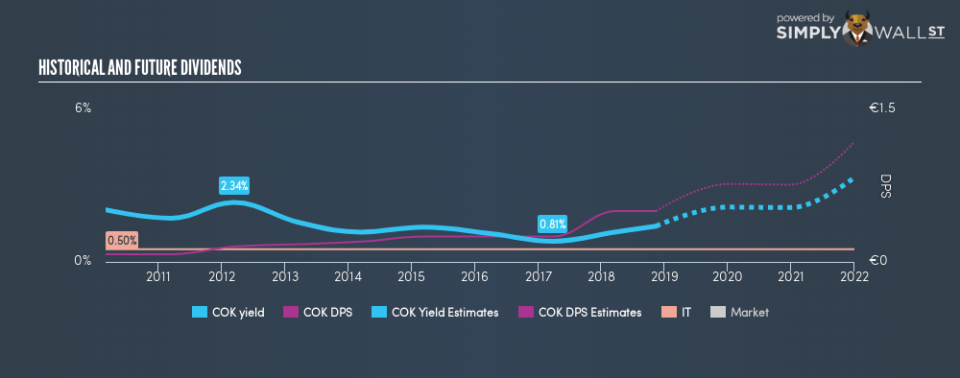Should You Buy Cancom SE (ETR:COK) For Its 1.4% Dividend?

A sizeable part of portfolio returns can be produced by dividend stocks due to their contribution to compounding returns in the long run. Historically, Cancom SE (ETR:COK) has paid a dividend to shareholders. It currently yields 1.4%. Should it have a place in your portfolio? Let’s take a look at Cancom in more detail.
See our latest analysis for Cancom
5 questions I ask before picking a dividend stock
When researching a dividend stock, I always follow the following screening criteria:
Is it paying an annual yield above 75% of dividend payers?
Does it consistently pay out dividends without missing a payment of significantly cutting payout?
Has dividend per share amount increased over the past?
Is its earnings sufficient to payout dividend at the current rate?
Will it be able to continue to payout at the current rate in the future?
How well does Cancom fit our criteria?
The company currently pays out 43% of its earnings as a dividend, according to its trailing twelve-month data, meaning the dividend is sufficiently covered by earnings. Going forward, analysts expect COK’s payout to remain around the same level at 40% of its earnings, which leads to a dividend yield of 2.2%. In addition to this, EPS should increase to €1.5.
When assessing the forecast sustainability of a dividend it is also worth considering the cash flow of the business. A company with strong cash flow, relative to earnings, can sometimes sustain a high pay out ratio.
If there is one thing that you want to be reliable in your life, it’s dividend stocks and their constant income stream. Unfortunately, it is really too early to view Cancom as a dividend investment. It has only been consistently paying dividends for 9 years, however, standard practice for reliable payers is to look for a 10-year minimum track record.
In terms of its peers, Cancom has a yield of 1.4%, which is high for IT stocks but still below the low risk savings rate.
Next Steps:
Now you know to keep in mind the reason why investors should be careful investing in Cancom for the dividend. But if you are not exclusively a dividend investor, the stock could still be an interesting investment opportunity. Given that this is purely a dividend analysis, I urge potential investors to try and get a good understanding of the underlying business and its fundamentals before deciding on an investment. There are three key aspects you should further examine:
Future Outlook: What are well-informed industry analysts predicting for COK’s future growth? Take a look at our free research report of analyst consensus for COK’s outlook.
Valuation: What is COK worth today? Even if the stock is a cash cow, it’s not worth an infinite price. The intrinsic value infographic in our free research report helps visualize whether COK is currently mispriced by the market.
Dividend Rockstars: Are there better dividend payers with stronger fundamentals out there? Check out our free list of these great stocks here.
To help readers see past the short term volatility of the financial market, we aim to bring you a long-term focused research analysis purely driven by fundamental data. Note that our analysis does not factor in the latest price-sensitive company announcements.
The author is an independent contributor and at the time of publication had no position in the stocks mentioned. For errors that warrant correction please contact the editor at editorial-team@simplywallst.com.

 Yahoo Finance
Yahoo Finance 
